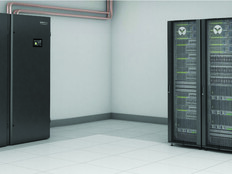Beat the Heat
To cool high-density computer installations, it’s crucial to start with the basics and apply some long-standing fundamentals of computer room management.
These must-dos include development and maintenance of a master layout plan, proper utilization of a cold aisle/hot aisle room configuration, and closure of openings in the raised floor and perimeter walls.
Many of these remediation steps can be achieved with available resources and will significantly address energy waste and performance inconsistencies. Here are five tips to keep your computing environment cool:
Tip 1: Quarantine that airflow.
Once the basics of the cold aisle/hot aisle approach are implemented, the next critical step is isolation of hot and cold air.
Proper implementation of the hot/cold cabinet layout effectively cools low-density cabinets. But once the cabinet density rises above 10 kilowatts, further isolation is necessary, and at 20 kilowatts complete isolation is required.In addition to isolation, once all the basics are accomplished, the next step is to perform a heat-load/cooling airflow balance of the facility.
Tip 2: Even out the cooling.
Effective and efficient cooling involves a careful balance of load and cooling response. One method for achieving this is by monitoring cabinet or power distribution unit loads and adjusting the cooling capacity as the load varies. This can be effectively accomplished through the use of supply-side temperature control of the airflow and the use of variable speed motors on the cooling fans.
By implementing controls on the cool air, as opposed to the return air, the cooling system works as a single unit and provides a uniform underfloor temperature. This eliminates variations in cooling units; these variations result in hot and cold spots as the load in different areas of the room varies.
Another advantage of supply-side control is the ability to monitor the performance of cooling units. If the supply air temperature from a cooling unit increases, either the unit is not performing to specification and maintenance is required or there is insufficient cooling capacity in that area.
The next step is the installation of variable frequency drives (VFDs) on the cooling fan motors. VFDs can accommodate variations in heat load resulting from fluctuations in load or new equipment installation. As the load rises or falls, the server cooling fans require more or less air respectively. The VFD fan motors make adjustments based on static pressure and/or server input air temperature.
There’s also a significant energy consumption advantage in using variable-speed motors. For an electric motor, the energy consumption is the cube of the motor speed. If an electric motor is operated at 80 percent of maximum speed, it uses just half of the full-speed energy; at 50 percent, an eighth of the energy.
Tip 3: Adjust the volume.
In conjunction with the implementation of supply side temperature control and VFD motors on fans, a more hands-on approach to load balancing is to monitor the static pressure between the cold and hot aisles, as well as the input air temperature to the servers.
When either of these measurements drifts out of the control range, the airflow volume can be adjusted to correct the deviation, thereby maintaining an even input air temperature to the servers and supplying the server cooling fans with the volume of air they require.
Tip 4: Raise the thermostat.

Another way to improve efficiency is to raise the operating temperature in the room to between 75 and 77 degrees. Transitioning from a return air control set point of 68 degrees to a supply-side control set point of 77 degrees can reduce cooling costs by 30 percent to 40 percent. That represents a paradigm shift from the traditional methods of managing a computer room and should only be implemented incrementally with constant monitoring to ensure a balanced cooling environment.
Tip 5: Keep your cool.
Cooling high-density loads is first and foremost an exercise in strict computer room management. Long-standing best practices are often disregarded even in low-density deployments. Is it reasonable to plan to cool 20-kilowatt racks in a facility that does not provide a stable thermal environment for 2- to 3-kilowatt racks?
Once known best practices are deployed, data center managers can move on to tactics such as VFDs, hot air or cold air isolation, and adjustments to the operating temperature.







